 Toronto Blue Jays 1B/DH Edwin Encarnacion had another great year with the bat in 2013. He posted a .272/.370/.534 line with a 148 wRC+ that was 6th in the AL. This was on the heels of a 2012 season where Encarnacion managed a 151 wRC+.
Toronto Blue Jays 1B/DH Edwin Encarnacion had another great year with the bat in 2013. He posted a .272/.370/.534 line with a 148 wRC+ that was 6th in the AL. This was on the heels of a 2012 season where Encarnacion managed a 151 wRC+.
In his late-career resurgence, Encarnacion has become the rarest of players, a power hitter that rarely strikes out. Only Chris Davis and Miguel Cabrera had more home runs than Encarnacion’s 36. The previous year, Encarnacion slammed 42 home runs.
Meanwhile, Encarnacion struck out in only 10% of his plate appearances. Only seven qualified hitters struck out at a lower rate than Encarnacion. None of them had more than 17 home runs.
Here’s a look at their numbers side by side.
| HR | BB% | K% | |
| Vintage Pujols | 40 | 13.1 | 9.5 |
| Encarnacion ’12-13 | 39 | 13.1 | 12.3 |
Pretty impressive, huh? Well, let’s dig even further. From 2001-11, the MLB average walk and strikeout rates were 8.5% and 17.3%, respectively. In 2012-13, they were 7.9%, and 19.9%, respectively. So, here are Pujols’ and Encarnacion’s numbers side by side expressed as a percentage of the MLB average.
| HR/PA | BB% | K% | |
| Vintage Pujols | 222% | 154% | 55% |
| Encarnacion ’12-13 | 238% | 165% | 62% |
So if we adjust for the MLB average, Edwin Encarnacion’s home run and walk rates from 2012-13 were better than those of vintage Albert Pujols. His strikeout rate was a shade worse. If I restricted the comparison to 2013, Encarnacion would be better in all three categories.
Does this mean that Encarnacion from 2012-13 has been the offensive equivalent of vintage Pujols? Well, not quite. Let’s revisit wRC+. Pujols average from 2001-11 was a robust 167. Encarnacion’s wRC+ from 2012-13 is 148. Where does this big difference come from?
Pujols in-play batting average in his prime years was .311. On the other hand, Encarnacion has just a .256 in-play average from 2012-13. That’s a very big difference. Only Darwin Barney had a worse in-play batting average than Encarnacion in that time frame.
Does Pujols hit more line drives? What’s the reason for this big split? Here are their batted ball ratios.
| LD% | GB% | FB% | IFFB% | |
| Vintage Pujols | 19.0 | 40.9 | 40.0 | 13.0 |
| Encarnacion ’12-13 | 19.6 | 34.1 | 46.3 | 10.7 |
Pretty similar. Pujols hits more ground balls, Encarnacion does a better job of avoiding the infield fly. In fact, based on these ratios, you would expect Encarnacion to have a higher in-play average than Pujols.
Recently teams have been using a unique shift against Encarnacion, where they put three infielders on the left side of second base. Here’s a picture below.

This shift has been successful in taking away plenty of hits from Encarnacion. Since 2012, he’s hit just .222 on ground balls, compared to .262 for vintage Pujols. In 2013, just 25 of the 170 groundballs Encarnacion hit found a hole.
On balls he pulls, Encarnacion has a .376 batting average. That might sound very good, but compare it to Pujols, who hit .477 on balls he pulled in his vintage years.
Edwin Encarnacion is an elite hitter. In terms of walks, strikeouts, and home runs, he’s every bit the hitter that Albert Pujols was during his prime years. Sure, his pull-heavy approach might allow the shift to take away some hits, but the shift can’t do anything about the balls he puts over the fence.
